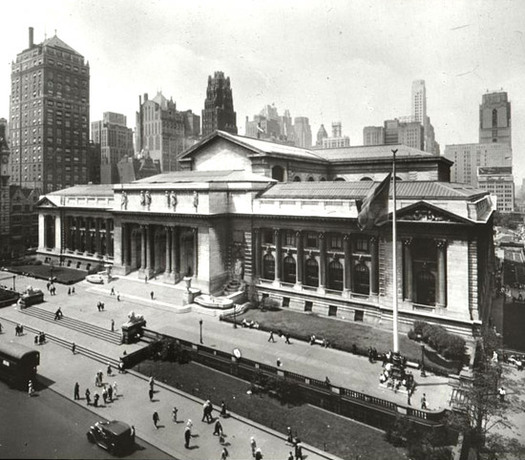
April 25, 2012
NYPL: Where’s the Model?

After several years flying under the public’s collective radar, an opposition is beginning to coalesce in response to the New York Public Library’s proposed Central Library Plan. For the uninitiated, this plan calls for a transformation of the NYPL’s main research library at a projected cost of some $350 million. The purpose is to consolidate the Mid-Manhattan lending library (now on 40th and Fifth) and the Science, Industry and Business Library (SIBL, now on 34th and Madison) within the walls of the main research library. Space for the two reconstituted libraries within the main building will be created by dismantling a large proportion of the stacks within the building, and moving the books held there to offsite storage. Norman Foster has been hired to carry out the plan.
The library has offered numerous arguments for this overhaul: Consolidation will reduce overall operating costs and thus free up funds for acquistion and programming; It will allow for significant expansion of computer workspace; It will allow for more dedicated space for scholars and writers; It will make for a more “democratic” library; It is wasteful to use one of the library’s great assets, its prime Fifth Avenue real estate, for storage. The library promises a new barcode system will allow it to deliver books from offsite in a timely fashion and reduce losses, and that the most-called books will remain in the building. These arguments are not to be dismissed. The library can’t help but face the future, and do so in a proactive way. It has already begun jts modernization campaign, a process that has included replacement of its pneumatic call system, and the introduction of cafe service, courtesy of Danny Meyer.
Nevertheless, many of us who use the library regularly are deeply concerned that consolidation will jeapordize its core research mission. Why, after a century, is it necessary to so drastically reshape the library? Is it wise to remove so many books from the library building? Will the new delivery system really work as promised? Is this the best use of funds, given the deteriorating state of the branches and reduced book buying budget? How will the already crowded library accomodate so much additional traffic? Will the demand for digital workspace actually be so great in the future, when the entire city may be wirelessly enabled? (And isn’t that the the job of the branches?) What does it really mean for an already-free library to be more “democratic”? Is the library, like so much in our culture, privileging consumption over production? Are we locking ourselves into a future of diminishing intellectual returns? What happens during construction?
These questions, and many others, have been raised elsewhere. (I highly recommend Caleb Crain’s exhaustive and exemplary coverage.) For good reason, critics have concentrated on what the proposed changes could mean for the library’s mission, and for the scholarly community. Those should be the first priorities in evaluating the plan, but as an architectural historian and critic, I am concerned with how these transformations will alter the landmark building itself.
Just what will be created, however, and how the changes will alter the library’s extant spaces is unclear. The library has not presented plans or a model of the proposed design, though stories in the Times indicate these materials do in fact exist.
The main research library is a public trust, one of the four or five cornerstone architectural landmarks of New York City, on par with Grand Central Terminal, Central Park, and the Brooklyn Bridge. It is defined as much by its magnificent rooms and circulation spaces as it is by its stately marble exterior. Though it cannot be perpetually frozen in time, its alteration is a task of extraordinary responsibility. It would seem imperative to me that the library present a model of the proposed modifications to this building to the public. If this new vision is something to be proud of — and it should be if it is to go ahead — why not put it on display right in the main lobby, an advertisement for all to see?
UPDATE (5/8/12)
I have been informed that, contrary to popular belief, there are not currently presentation drawings, plans, or a model of the proposed conversion of the library in accordance with the CLP. Architectural plans are now in design development in the Foster office, and will be presented to the public in the fall of this year, if the library’s schedule holds.
Observed
View all
Observed
By Mark Lamster
Related Posts

Equity Observer
L’Oreal Thompson Payton|Essays
‘Misogynoir is a distraction’: Moya Bailey on why Kamala Harris (or any U.S. president) is not going to save us

Equity Observer
Ellen McGirt|Essays
I’m looking for a dad in finance

She the People
Aimee Allison|Audio
She the People with Aimee Allison, a new podcast from Design Observer

Equity Observer
Kevin Bethune|Essays
Oh My, AI
Related Posts

Equity Observer
L’Oreal Thompson Payton|Essays
‘Misogynoir is a distraction’: Moya Bailey on why Kamala Harris (or any U.S. president) is not going to save us

Equity Observer
Ellen McGirt|Essays
I’m looking for a dad in finance

She the People
Aimee Allison|Audio
She the People with Aimee Allison, a new podcast from Design Observer

Equity Observer
Kevin Bethune|Essays
